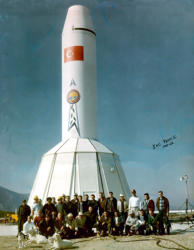
Jupiter SM-78 Weapon System
I&C Team 2, Çigli AB, Turkey 1961-1962 Chrysler Corporation Missile Division


HISTORY - Page 7
June, another presentation was made to Washington officials proposing development for a ballistic missile
system of 1,000 or more nautical miles range. Throughout this study, it was repeatedly stressed that this
development could be effected by redesign of existing components. The REDSTONE had served as an
excellent laboratory and could still be used in such a way to test and prove long-range missile components.
In fact, 19 REDSTONES been earmarked for these purposes, especially with regard to resolving the nose
cone re-entry problem. A number of alternative methods were included as to the way in which the missile
could be employed, which involved ranges above and below the 1,000- mile mark. All of these proposals
hinged on the use of NAA's engine, which was now rated at 135,000 pounds of thrust and had undergone
some 334 static tests
9
. No active results came from this proposal.
Continuing with the successive monthly proposals, Redstone Arsenal, in July, dropped all
recommendations for shorter range and concentrated on the 1,500-mile version. As to characteristics of
the weapon being considered, it was to be a single-stage, liquid-fuel ballistic rocket designed to carry a
2,000-pound payload to the specified range. A swivel-mounted 150,000-pound thrust NAA engine would be
used as the power unit (static tests of engines of this capability had already been conducted). The missile
would have a diameter of 95 inches and a length of 1,114 inches. Propulsion would be provided by using
45,860 pounds of JP4 as fuel and 103,120 pounds of L0X as the oxidizer to acquire a maximum burning time
of 119.3 seconds. Launching weight would be 167,000 pounds. The missile was not fin controlled but,
instead, would have attached two hydrogen peroxide vernier thrust nozzles of 1,000 pounds of thrust
______________________________
9. RSA OML Study, 13 Jun 55, subj; OML Prop for a Ball GM sys of 1,000 or More NM Range, Hist Off files.










HISTORY - Page 7
June, another presentation was made to Washington
officials proposing development for a ballistic missile
system of 1,000 or more nautical miles range.
Throughout this study, it was repeatedly stressed that
this development could be effected by redesign of
existing components. The REDSTONE had served as an
excellent laboratory and could still be used in such a
way to test and prove long-range missile components.
In fact, 19 REDSTONES been earmarked for these
purposes, especially with regard to resolving the nose
cone re-entry problem. A number of alternative
methods were included as to the way in which the
missile could be employed, which involved ranges
above and below the 1,000- mile mark. All of these
proposals hinged on the use of NAA's engine, which
was now rated at 135,000 pounds of thrust and had
undergone some 334 static tests
9
. No active results
came from this proposal.
Continuing with the successive monthly proposals,
Redstone Arsenal, in July, dropped all
recommendations for shorter range and concentrated
on the 1,500-mile version. As to characteristics of the
weapon being considered, it was to be a single-stage,
liquid-fuel ballistic rocket designed to carry a 2,000-
pound payload to the specified range. A swivel-
mounted 150,000-pound thrust NAA engine would be
used as the power unit (static tests of engines of this
capability had already been conducted). The missile
would have a diameter of 95 inches and a length of
1,114 inches. Propulsion would be provided by using
45,860 pounds of JP4 as fuel and 103,120 pounds of L0X
as the oxidizer to acquire a maximum burning time of
119.3 seconds. Launching weight would be 167,000
pounds. The missile was not fin controlled but,
instead, would have attached two hydrogen peroxide
vernier thrust nozzles of 1,000 pounds of thrust
______________________________
9. RSA OML Study, 13 Jun 55, subj; OML Prop for a Ball GM sys of 1,000 or More NM Range, Hist Off files.





















